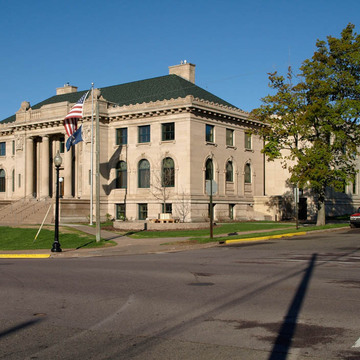By the end of 2000, the landmark Peter White Library was rehabilitated into a twenty-first-century community cultural center with spaces for various activities. The Beaux-Arts classical library is constructed of smooth-cut grayish-white Bedford limestone and contrasts sharply with the warm reddish-brown brick and sandstone buildings in the Gothic, Italianate, and Richardsonian Romanesque styles that were constructed in the preceding thirty years in Marquette. The library board explained that it chose white stone “so as to furnish a variation to the dark stone which is characteristic of the architecture of Marquette.” Round-arched windows with keystones pierce the walls on the raised first story; the second-story windows are rectangular. An ornamental cornice encircles the red tile hipped roof. Stairs ascend to the projecting central entrance portico, which is marked by four giant fluted columns in antis.
The building was named for White (1830–1908), founder in 1872 of the public library in Marquette. Together with Nathan M. Kaufman and John M. Longyear, he was also a substantial contributor to the present building. As a member of the World's Columbian Exposition of 1893 commission, White probably admired the white classicism of the exposition buildings in Chicago. Patton and Miller, the Chicago firm that designed the library, was noted for its designs for libraries and college buildings.
The library's expansion and renovation doubled its size. With limestone exterior walls, window placements that follow the original, and the retention of the historic and monumental North Front Street entrance (east), the addition is sensitive to the historic building. Like the Grand Rapids Public Library ( KT14), the Peter White Library marks the need of communities to revitalize their libraries for today's expanded purposes. Combining the old with the new represents the best solution.















